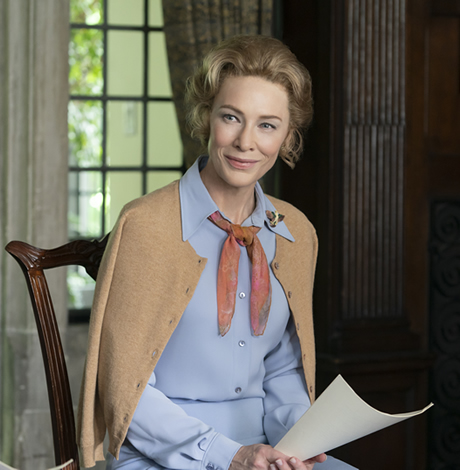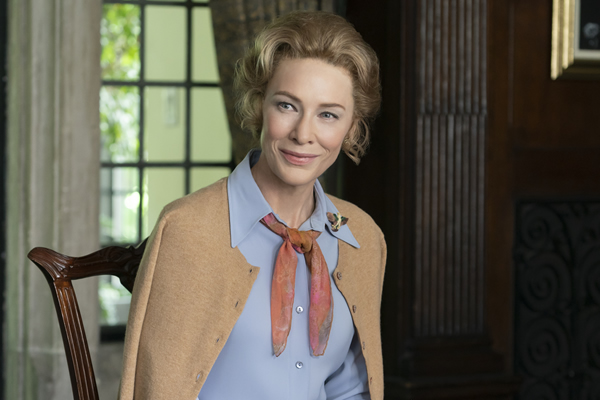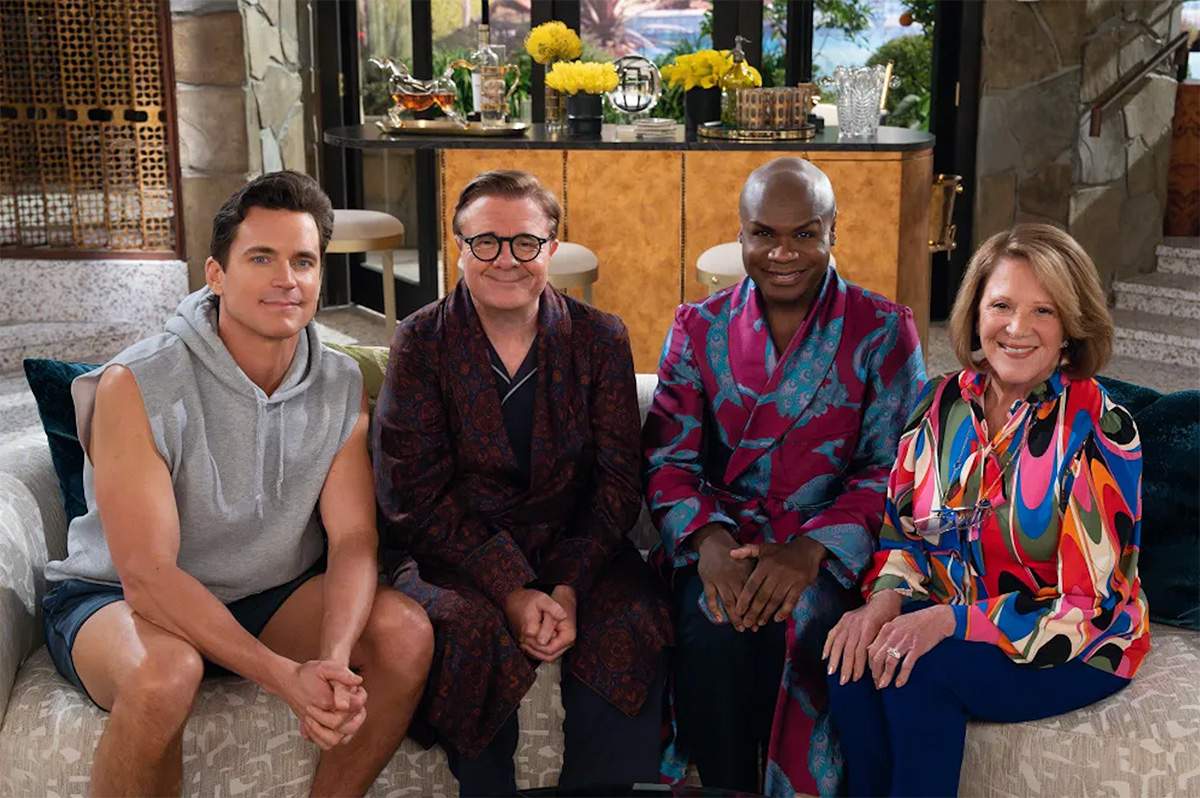Television
‘Mrs. America’ is best cure for cabin fever
Hulu series focuses on battle over the ERA


“We’re all secretaries to them.”
“Mrs. America” is a dazzling triumph, must-see TV of the highest quality and a much-needed antidote to cabin fever.
The nine-episode series by FX on Hulu is about the riveting battle over the Equal Rights Amendment (ERA). It’s broad and ambitious in scope, clearly and effortlessly capturing the epic flow of history, yet richly nuanced and finely detailed in it storytelling, capturing the quirks and foibles of leaders on both sides of the battle and drawing well-rounded portraits of the fascinating people who left their marks on American political history.
Running from 1971 (the introduction of the ERA) through 1980 (the election of Ronald Reagan), the series centers on Phyllis Schlafly, “the sweetheart of the silent majority,” a conservative activist who played a crucial role in Republican politics from her support of Barry Goldwater in 1964 to her support of Donald Trump in 2016.
As the series opens, Schlafly is producing the influential “Phyllis Schlafly Report” with a dedicated cadre of volunteers. Her primary interest is national defense (she has a master’s degree in government), but she quickly realizes that opposition to the ERA can be her most effective organizing tool. She develops a highly effective campaign that combines fear-mongering (“do you want your daughter to be a lesbian?”) with a positive message (pro-family, pro-life, pro-America). She launches STOP ERA and the Eagle Forum.
Schlafly’s grassroots approach successfully ambushed supporters of the ERA who had lined up broad bipartisan support for the amendment that would guarantee equal protection on the basis of sex. The bill had easily passed both houses of Congress with support from President Richard Nixon (and subsequent support from Presidents Gerald Ford and Jimmy Carter); by 1972 the amendment had been ratified by 28 of the 38 states required for enactment. Schlafly’s intervention stopped that progress in its tracks.
Series creator and showrunner Dahvi Waller wisely keeps the fascinating figure of Schlafly front and center through all nine episodes of the series, but uses a clever narrative strategy to tell the other side of the story. The first episode introduces the group of fierce second-wave feminists who support the ERA and each subsequent episode spotlights one of the feminist leaders.
The second episode spotlights Gloria Steinem (a groovy performance by Rose Byrne); the third episode focuses on Shirley Chisholm (played with precision and passion by Uzo Aduba) and her historic run for president; and the fourth episode turns to Betty Friedan, widely considered the mother of the feminist movement (a wonderfully intense performance by Tracey Ullman).
Episode five recreates the prime-time “couples debate” between the traditional Phyllis and Fred Schlafly and the liberated Brenda and Marc Feigen-Fasteau. LGBT issues rise to the surface as Brenda has an affair with a female photographer and Phyllis discovers that her eldest son John is gay.
Episode six focuses on Republican Party politics. As Phyllis tries to move the party to the right, Jill Ruckelshaus (the exquisite Elizabeth Banks in a finely tuned performance) debates how to shore up support for the ERA. Episode seven centers on the abrasive Bella Abzug (a bravura display by Margo Martindale).
Episode eight brings all of the characters together at the National Women’s Conference in Houston. The fierce floor battle includes a fight over support for lesbian rights. Episode nine effectively wraps things up with a focus on presidential politics: Abzug is fired as chair of Carter’s National Advisory Committee for Women and Schlafly helps Ronald Reagan win the Republican nomination and the general election.
Waller and her writing staff do an amazing job at presenting all of this material in a clear, concise and compelling manner. They find the fiery passions beneath the rigorous intellectual and political debates on both sides of the issue and fearlessly probe the private costs of living very public lives. Some of the minor characters do get lost along the way, but overall, the series creates complete and complex story arcs for all of the principal characters.
Waller and her directing and design team bring the 1970s to vivid life. The period detail is impeccable; it is incredible to see how quickly technology and shifting norms have changed American society. It’s a great character note that Phyllis is an early technology adapter; she happily trades in her typewriter for a computer and brags that she can fit her entire mailing list on one of the new floppy disks.
Cigarettes are everywhere; fortunately, that has changed. Sexist attitudes are also everywhere; sadly, that has not entirely gone away. All of the women are subject to second-class treatment. In an early episode, Phyllis is asked to take notes during a meeting with Sen. Goldwater; later when Bella and Shirley are dismissed as they try to stop the sexual harassment of congressional staff, Bella wryly observes, “we’re all secretaries to them.” As the #metoo movement demonstrates, that battle continues.
The acting is top-notch. Blanchett shines in her rich multi-faceted portrayal of Schlafly and embraces all of the character’s prickly contradictions. She promotes traditional family values, yet leaves her own family in the care of an African-American maid; she loves her husband and asks for his guidance in presenting her legal arguments, but joyfully manipulates him when necessary. She’s ruthless, passionate, blazingly intelligent, proudly stylish and all too willing to bend the truth to make her case. Blanchett’s work is sure to dominate awards season (whenever that happens).
The supporting cast is equally strong. John Slattery is great as the devoted Fred Schlafly and Jeanne Tripplehorn is heartbreaking as his unmarried (and therefore invisible) sister Eleanor. Niecy Nash is pure dynamite as feminist activist Flo Kennedy and James Marsden is wonderful as the condescending Phil Crain who always gets outplayed by Phyllis. Melanie Lynskey is delightful as Rosemary Thomson, an ambitious member of STOP ERA who frequently brings some lovely humor to the proceedings.
Most notably, Sarah Paulson is terrific as Alice Macray, a character created by Waller, who starts out as one of Phyllis’s most dedicated supporters. One of the best scenes in the entire series is when a slightly tipsy Alice strikes up a conversation with another delegate at the National Women’s Convention. The two happily swap pictures and sip Pink Ladies until Alice discovers that her new friend is an ERA supporter and she flees in terror.
The first three episodes of FX on Hulu’s “Mrs. America” will drop on Hulu on April 15; subsequent episodes will drop weekly.
The series is an excellent history lesson, but it also shines a powerful spotlight on contemporary politics. The battle over the ERA, which has still not been enacted, brought about a seismic shift in American politics. Like the infamous Roy Cohn, Phyllis Schlafly is part of a conservative movement that moved the Republic Party from Barry Goldwater to Donald Trump and silenced the party’s moderate wing. Like the second wave feminists, progressive activists still struggle with intersectional politics and developing a unified and effective opposition.
As Alice Macray wonders, is there a way to start to build bridges and move forward?

There’s long been a desire for a gay version of “The Golden Girls.”
GenX (and younger) fans who have loved that show’s iconic quartet of aging female “frenemies” have been clamoring for it since the actual “Golden Girls” was still on the air – so by the time the creators of “Mid-Century Modern” came up with the concept for a show about three gay friends “of a certain age” (and one cantankerous mother) living together in Palm Springs, it was hardly an original idea. Yet even if they weren’t the first to fantasize about a show featuring the gay male equivalents of Dorothy, Blanche, Rose, and Sophia, it hardly matters. They were the ones that actually made it happen.
That’s due in large part to who they are – or at least, what they’ve done before. The two men who hatched the plot (Max Mutchnick and David Kohan) were also responsible for “Will & Grace.” After they teamed up for a brainstorming session with queer TV powerhouse Ryan Murphy – who eagerly joined forces with them as the show’s executive producer – there was enough viability behind it to bring the long-gestated dream to fruition at last.
The “at last” came this week, when all 10 episodes of the show’s debut season dropped on Hulu, and it’s undeniable that there was not only a dream behind it, but also a considerable amount of talent – most obviously in its casting. Headlining (as “lingerie mogul” Bunny Schneiderman) is longtime stage/screen/TV star Nathan Lane, a multi-award winner who is a legend for his “Bird Cage” performance alone, with eternally hunky Matt Bomer adding a whole different flavor of star power as ditsy-but-sweet-hearted (and blithely promiscuous) flight attendant Jerry. The trio of friends is rounded out by former fashion columnist Arthur, played with imperious aplomb by Nathan Lee Graham, a lesser-known but equally well-rounded veteran performer whose resume includes roles in “Zoolander” and “Priscilla, Queen of the Desert,” and as a guest appearance on “Absolutely Fabulous.” Finally, sitcom royalty (and Tony-winner) Linda Lavin – who passed away in December, after filming had completed on the show’s inaugural season – is on hand to steal scenes as Sybil, Bunny’s pull-no-punches mother, who owns the house they all live in and makes sure to assert her matriarchal dominance at every opportunity.
In the pilot episode, titled “Bye, George,” Bunny, Jerry, and Arthur reunite to mourn the death of an old companion, with whom the trio of friends once formed a quartet. With each of them facing the uncertainty of a new life after changes in the old one have left them to cope on their own, Bunny decides to invite his two remaining buddies to move to Palm Springs and live with he and his mother, in a spectacular mid-century modern (hence the name) house that would probably make Frank Sinatra jealous. The arrangement, however, becomes precarious even before it officially begins, when Bunny connects with a much-younger hook-up and becomes smitten – forcing his two would-be roommates into a scheme to bring him back to his senses before he rescinds their invitation and offers it to his new “boyfriend” instead. It’s classic sitcom material, of course, with lots of crossed wires and jumped conclusions to fuel the wackiness – though in this case, at least, the show stops short of the zany hijinks one might expect from Lucy and Ethel (or even Rose or Blanche) before wrapping things up in a friendship-affirming bow. We can’t fault it for that; there’s a premise to be launched here, after all.
Besides, there’s plenty of other comfortable old-school sitcom fun to be had throughout: a sparring match between Arthur and Sybil, whose love-hate dynamic quickly sets the stage for an ongoing battle of sharp wits and sharper tongues; the air-headed naivete of Jerry, with Bomer both leaning into and undercutting the cliché of the pretty-but-dumb aging “twunk”; and Bunny’s sincere but impulsive starry-eyed sentimentality, which is frequently undercut by his “Dorothy-esque” natural instinct (and Lane’s natural talent) for bitchy queendom.
Yet while there are clear choices to mirror the iconic personality traits of the original “Golden Girls” crew in “Mid-Century Modern,” the new series seems less regimented in defining each of its characters quite so succinctly, opting instead for a sort of “blend” in which the familiar personas of the former show’s leading ladies are spread a little more evenly between the four of them together. The result is a show that is obviously a new variation on an established theme, but one in which echoes of the original can be detected in each of its disparate elements rather than confined within the plainly-delineated parameters from which they have been inherited. To put it more plainly, it’s a show that acknowledges and embraces the material which inspired it, but goes beyond mere imitation to carve a space of its own. Neither a remake nor a reboot, it’s more like an offspring, a separate entity unto itself despite the DNA it shares with its progenitor.
Which is, of course, the only way a show like this can have any real chance of success; to attempt a direct copy of the series that inspired it would spark inevitable (and well-deserved) criticisms of laziness, along with the myriad quibbles which would undoubtedly arise from displeased “Golden Girls” fans; yet to diverge too radically from the established format would eliminate the very reason for its existence. Its seasoned creators were savvy enough to know that a gimmick only goes so far, and they build a show that leaves room for growth beyond its origin as a nostalgic homage into a series with the potential to succeed in its own right. And with the first season helmed by director James Burrows (an 11-time Emmy-winner for his work on shows like “Taxi,” “Cheers” “Frasier” and “Will & Grace”), who brings the experienced hand necessary to create the kind of authentically “retro” piece of entertainment that this one aspires to be, the old-school vibe feels as fresh as it did when “The Golden Girls” debuted – almost 40 full years ago.
Whether that nostalgic pull is enough to make the show a hit is hard to predict. It has laugh-out-loud moments, and convincingly reasserts the importance of genuine friendship and chosen family that has always been a common element in such shows. At the same time, while “The Golden Girls” was unequivocally queer-friendly, it was not specifically queer-themed. Given today’s polarized sensibilities around queer content, the timing might be wrong to permit this decidedly queer evolution of its premise – which saucily permits plenty of fodder for colorfully-phrased quips about the spicier details of queer sexuality – to have the same universal appeal that made the earlier show into a long-running mainstream hit.
Only time will tell. For now, you can watch the entire first season on Hulu, and make that call for yourself. For our part, we’re just happy to have another high-profile queer show to enjoy, because we all really need that right about now.

It’s time to plan out our screen time for the next few months, as our favorite television platforms prepare to launch a whole new assortment of bingeable distractions for us – and we’re delighted to say that this year’s crop includes an intriguing array of queer and queer-related choices to add to our list. As always, the Blade is here with the details.
Lost Boys & Fairies (miniseries, March 4, Britbox) Already streaming this spring is this acclaimed BBC production from 2024, a heartwarming three-episode saga about a Welsh gay couple (Siôn Daniel Young and Fra Fee) and their effort to adopt a child. Though the story is queer, the issues it tackles are universal – hesitance to become a parent because of past issues or fear of failure, coming to terms with an unhappy childhood, and grappling with the daunting prospect of being a parent when you’re not even sure you are capable of managing your own life, among others – and strike all the right notes to make this series a touchstone for anyone with a desire to celebrate the reality of taking on the responsibility of raising a child. Elizabeth Berrington, Sharon D. Clarke, Maria Doyle Kennedy, William Thomas, and Arwel Gruffydd also star.
The Parenting (movie, March 13, Max) In this made-for-TV feature film, a young gay couple, Rohan and Josh (Nik Dodani and Brandon Flynn), rent a country house to host a weekend getaway with their respective parents, only to discover that the three couples are sharing the space with a 400-year-old evil entity. Directed by Craig Johnson, this horror comedy has automatic “fan” appeal provided by its stars – especially Flynn (“13 Reasons Why”), who has acquired a gay heartthrob status that stretches beyond his “queer youth” demographic – and its embrace of the always popular (if campy) “haunted house” genre. It also boasts an impressive supporting cast, including Parker Posey (“Best in Show,” “The White Lotus”), Brian Cox (“Succession”), Lisa Kudrow (“Friends,” “Romy and Michele’s High School Reunion”), Dean Norris (“Breaking Bad,” “Claws”), and Edie Falco (“The Sopranos,” “Nurse Jackie”). It should be fun.
O’Dessa (movie, March 20, Hulu) An ambitious project from writer/director Geremy Jasper, this self-described “post-apocalyptic musical drama” follows a farm girl in the future as “she goes on a journey” in search of “a family heirloom” while attempting to “rescue her one true love.” Developed by Disney’s “prestige” Searchlight Pictures division and featuring a music-and-song score by Jasper and Jason Binnick, it premiered a mere week ago at 2025’s South by Southwest Festival and stars Sadie Sink (“Stranger Things”) alongside Regina Hall (“Scary Movie,” “Girls’ Trip”), Murray Bartlett (“Looking,” “The White Lotus”), Kelvin Harrison, Jr. (“Elvis,” “Chevalier”), and singer-songwriter Pokey LaFarge.
Dope Thief (miniseries, March 14, Apple TV) A novel by Dennis Tafoya is the inspiration for this gritty miniseries about a pair of former hoods who pose as DEA agents for a robbery and discover the biggest secret drug operation on America’s Eastern Seaboard. This one makes our list solely because of the star power of its headliner, acclaimed out Black actor Brian Tyree Henry (“Atlanta”, “Eternals”), who gives a rock solid performance alongside co-star Wagner Moura. Also featuring power players like Ving Rhames (“Pulp Fiction”) and Kate Mulgrew (“Star Trek: Voyager,” “Orange is the New Black”), as well as Amir Arison, Marin Ireland, and Nesta Cooper, it’s the kind of tense-but-engrossing, character-driven crime drama that long-form TV narratives seem to pull off better than any other platform.
RuPaul’s Drag Race Live (special, March 16, WOW Presents Plus) Fans of the iconic RuPaul won’t want to miss this special event broadcast, when the 1,000th performance of the groundbreaking “reality competition” show’s live residency at Las Vegas’s Flamingo Resort will air on World of Wonder’s WOW Presents Plus platform. Featuring choreography from Jamal Sims, direction from RuPaul, and performances by current cast of Queens Asia O’Hara, Ginger Minj, Jaida Essence Hall, Kylie Sonique Love, Morphine Love Dion, and Plane Jane, along with multiple special surprise guests spectators, sickening lip-syncs, and the ever-popular (and ever-handsome) Pit Crew, it’s undoubtedly going to be the next best thing to being there.
The Residence (series, March 20, Netflix) As if we’re not seeing enough drama from the White House these days, Netflix is delivering this mystery miniseries about a fictional murder investigation among the staff of America’s most famous mansion, from none other than the popular Shonda Rhimes-led powerhouse Shondaland production company (“Grey’s Anatomy,” “How to Get Away With Murder,” “Bridgerton”). Starring Udo Adubo (“Orange is the New Black”) as its leading sleuth, it also boasts an ensemble cast that includes Giancarlo Esposito (“Breaking Bad,” “The Mandalorian”), Susan Kelechi Watson (“This Is Us”), Jason Lee (“My Name is Earl”), Ken Marino (“The State,” “The Other Two”), Randall Park (“Fresh Off the Boat”) and Bronson Pinchot (“Perfect Strangers”), among many others. As if that weren’t enough, it promises appearances from beloved “SNL” alums Jane Curtin and Al Franken, as well as a guest starring turn by Kylie Minogue herself, which in itself is more than enough reason to include it on any list of must-see queer TV, if you ask us.
Mid-Century Modern (series, March 28, Hulu) The most eagerly anticipated queer entry of the spring TV season comes late in the line-up, but it is sure to be worth the wait. Centered on three best friends – all gay men of “a certain age” – shaken by an unexpected death, who decide to spend their golden years living together in Palm Springs, it’s a comedy that celebrates chosen family while also poking fun at the foibles of “the rich gays” (as Jennifer Coolidge’s Tonya McQuaid might brand them). It’s probably the closest thing we’ll ever see to the “Gay Golden Girls” remake for which so many among us have long dreamed – and with a cast led by Nathan Lane, Matt Bomer, Nathan Lee Graham, and the late Linda Lavin, odds are good that it can match the high expectations that surround it. Also featuring a roster of guest stars that includes Pamela Adlon, Vanessa Bayer, Kimberly Coles, Jesse Tyler Ferguson, Judd Hirsch, Richard Kind, Stephanie Koenig, Billie Lourd, Esther Moon Wu, Jaime Moyer, Cheri Oteri, Rhea Perlman, Zane Phillips, and more.
Television
Putting off watching ‘Monsters?’ You’re missing out
Netflix hit about Menendez killings is awards-worthy TV

You know it’s there. It’s been lurking in your Netflix queue for weeks now, taunting you, beckoning you with its sure promise of sexy, lurid thrills, but you’ve been holding back – and we can’t say we blame you. After all, that “Dahmer” show was pretty hard to watch.
For many Netflix viewers, there have been no such qualms; though Ryan Murphy’s “Monsters: The Lyle and Erik Menendez Story” debuted nearly a month ago, it’s currently the platform’s #3 most-watched series in the U.S., despite mixed reviews from critics and controversy over the way the show’s narrative depicts the facts of the notorious 1989 murder that put the two brothers in the national spotlight through two highly publicized trials. Even if killing their wealthy parents put the Menandez brothers into prison for life, it also put them into the upper echelon of “True Crime” superstars, and that makes anything dealing with their story “must-see TV” for a lot of people.
If you’re one of those who have resisted it so far, it’s likely your reasons have something to do with the very things that make it so irresistible to so many others. It’s hard to imagine a more sensational (or more gruesome) crime story than the tale of Lyle and Erik (Nicholas Alexander Chavez and Cooper Koch), who killed their wealthy parents with multiple shotgun blasts in their Beverly Hills mansion, claimed the deaths were the result of an organized crime “hit,” and then went on an extravagant spending spree with their multi-million-dollar inheritance. Even knowing just those surface details, it’s brimming with circumstances that conjure deep and troubling questions, not least about how two abundantly fortunate young men – Lyle was 21 at the time of the killing, Erik only 18 – could possibly have become capable of such a horrific act; their claim they acted in fear, after years of sexual and psychological abuse from their parents, offers answers that only leads to more questions. It’s easy to see how a morbid fascination could develop around the case (and the perpetrators, who at the time were each charismatic, handsome, and somehow boyishly adorable in spite of the silver-spoon detachment they seemed to exude) in a society endlessly fascinated by the dirty secrets and bad behavior of rich, beautiful people.
That, of course, makes the Menendez saga a natural fit with Ryan Murphy’s brand of television, which embraces the sensationalism of whatever subject it tackles – as we’ve seen from the transgressively macabre twists of “American Horror Story” to the scandal-icious celebrity backbiting of “Feud” to the campy noir-flavored psychopathy of “Ratched.” His “American Crime Story” anthology has delivered its true-life dramas with an equal eye toward creating those “WTF?” moments that inevitably have social media buzzing with both glee and outrage the morning after they drop, and the “Monster” franchise is a natural progression, which employs Murphy’s shrewd knack for cultural provocation to unearth the underlying social dysfunctions that help create an environment in which such killers can be created.
With the inaugural installment, “Monster: The Jeffrey Dahmer Story,” it can be argued that he crafted a chilling masterpiece of binge-able long-form storytelling that not only took viewers into the unspeakable horrors that took place in the killer’s apartment, but into the mind of the man who committed them. Yet while the show proved successful, earning an impressive tally of critical accolades, it was met with a harsher tone – much of it from families of Dahmer’s real-life victims – for capitalizing on his crimes.
For “Menendez,” the reception has been predictably similar. Its critical reception has not been quite as warm, with many reviewers taking issue with Murphy’s signature slicked-up style and the show’s overt homoeroticism, but the controversies have come just as expected. Objections over the extremely unflattering portrayal of José and Kitty Mendez (the ill-fated parents, played here with star-power intensity by Javier Bardem and Chloë Sevigny), and of the incestuous bond alleged between the title characters themselves, have arisen alongside complaints about the perceived distortion of facts — which here support a narrative, favoring the boys’ version of events, that Murphy (who co-wrote the series as well as producing it) wants to advance.
It’s certainly fair to claim that Murphy plays fast and loose with facts; his purpose here is not to transcribe events, like a docuseries, but to interpret them. He and his fellow writers craft “Monsters” theatrically, with bold strokes and operatic crescendos: they mine it for black humor and milk it for emotional intensity, matching a visual aesthetic that plays up the brothers’ pretty-boy charms, caressing their sculpted bodies with the camera and frequently showing them in various states of near or total nudity. Less obvious, but perhaps more to the true point of the project, the series fixates on the messy, petty, and ignoble traits of its characters, and illuminate the self-serving personal motives driving their public agendas; it even employs a “Rashomon”-esque approach in which it variously portrays different versions of the same events depending on the character describing them. In short, it’s not a show that is looking for factual truth; it’s searching for a more complex truth behind the facts.
That truth, perhaps, has a lot to do with the shame, stigma, and silence around abuse; the tendency to disbelieve the victims (especially when they are male – a prosecutor during the trials famously argued that men “couldn’t be raped”); and the cultural homophobia that further complicates the dynamic when the abuse comes from someone of the same sex. Does such abuse warrant absolution for murder, especially when the murder is as excessively brutal as the killing of José and Kitty Menendez? That’s a question Murphy and crew leave up to the viewers.
Such moral ambiguity is surely part of the reason that shows like “Monsters” and its predecessor are met with such hostility from some viewers; they offer no easy comfort, no straightforward moral order to reassure us that our perceptions of good and evil are just or fair or even correct – and if you’re looking for a hero to step forward and make sense of it all for us, you’re not going to find one.
If that’s too bleak a prospect for you, or if the notion of criminals as celebrities is something you’re just not comfortable enough with to make allowances for artistic intention, then “Monsters” may not be for you.
For anyone else who has hesitated to watch, however, it’s a show worthy of your time. Though it might seem uneven, even disjointed at times, it paints an overall picture of the Menendez case that is about something much more than the murders – or the murderers – themselves. The performances are all accomplished, well-tuned together to a sort of elevated authenticity, with particular praise for a jaw-dropping star turn by Koch, who monologues his way through a full-length one-shot episode that was filmed in a single take.
The latter alone is enough to make “Monsters” an awards-worthy piece of television. While it may not be the right show for every taste, it’s not “trash TV” either. It’s a bold and challenging work from one of our most prolific and dedicated queer showmen, and if it leaves you feeling sorry for monsters, is that really such a bad thing?
-

 Opinions5 days ago
Opinions5 days agoIt’s time for new leadership on the Maryland LGBTQIA+ Commission
-

 The White House5 days ago
The White House5 days agoWhite House does not ‘respond’ to reporters’ requests with pronouns included
-

 Arts & Entertainment5 days ago
Arts & Entertainment5 days ago‘Gay is Good’ Pride Pils Can Celebrates Frank Kameny’s 100th Birthday for WorldPride in D.C.
-

 Sponsored5 days ago
Sponsored5 days agoTHC Drinks: What You Should Know About Cannabis Beverages









